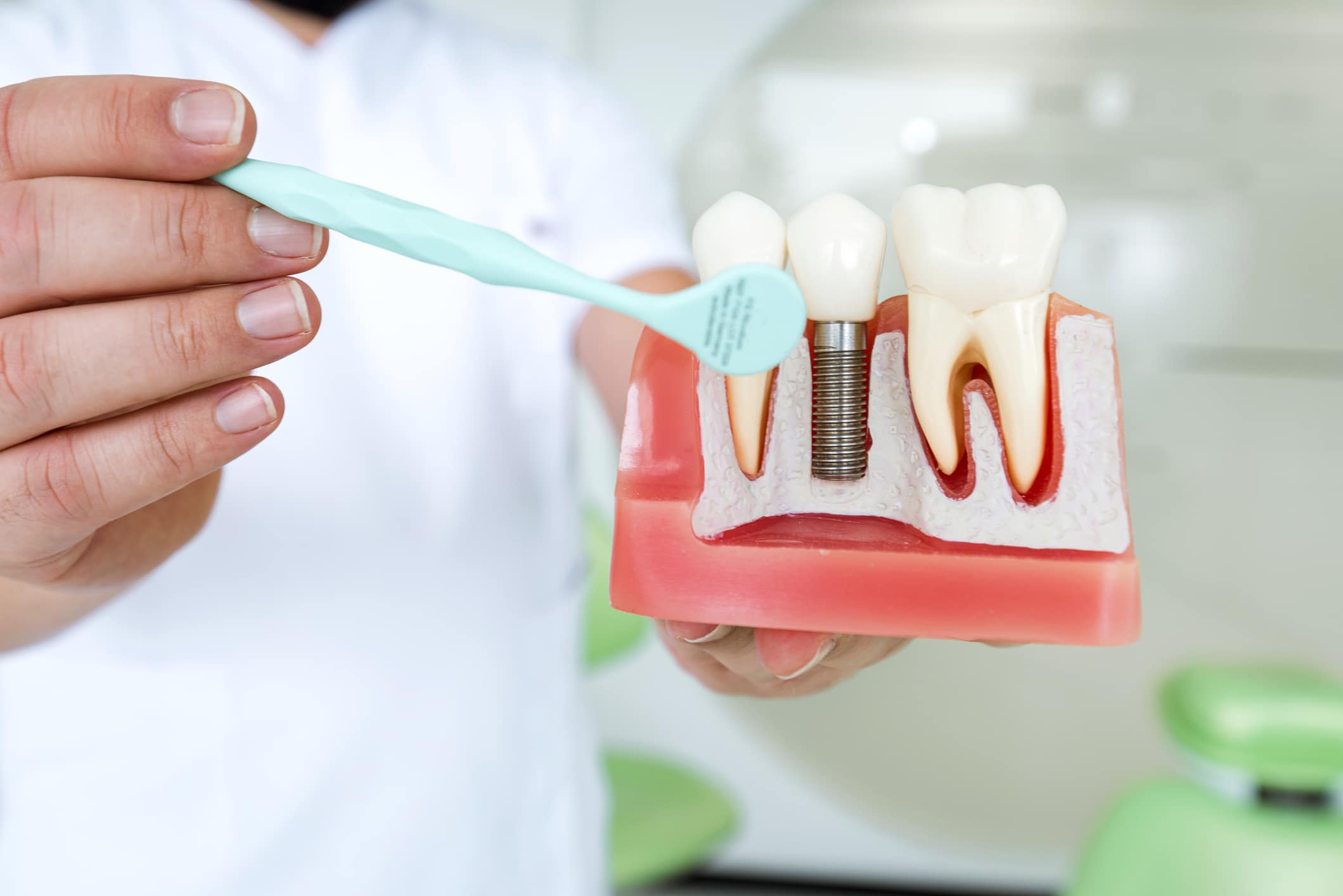Losing a tooth isn’t something anyone looks forward to, but it’s a reality many face. Research has shown that on average, 1 in 25 (4%) Australian adults have lost at least one tooth, and the risk of tooth loss increases with age.
Replacing missing teeth can be important not just for appearance, but also to maintain proper alignment of your remaining teeth, maintaining jaw and facial structure, and ensure you can chew and speak without difficulty. Two popular solutions that we’ll compare in this article are dental implants and bridges.
Understanding dental implants
You can imagine dental implants as secure anchors in your jaw that replace missing teeth with something that functions like a real tooth. The implants are made from titanium and are placed right into your jawbone during surgery. On top of this implant, a custom-made crown is added to complete your smile.
Here’s an overview of the dental implant treatment process:
- Removal of the damaged tooth (if it’s still there).
- Bone grafting might be needed if there isn’t enough bone to hold the implant.
- The implant is placed into the jawbone.
- A healing abutment is placed for the gum to grow around.
- Finally, the crown (the new tooth) is secured on top of the implant.
Once healed, it’s as though you’ve never lost a tooth at all.
Understanding dental bridges
Dental bridges span the space where a tooth is missing and uses the surrounding teeth as support – much like an actual bridge relies on its beams for support.
Here’s an overview of the dental bridge treatment process:
- Removal of the damaged tooth (if it’s still there).
- Preparing the neighbouring teeth for crowns that will support the bridge.
- Placing temporary bridge or crowns to protect the teeth while the bridge is being made in the lab.
- Cementing the new bridge (2 crowns with an artificial tooth or pontic in the gap).
Bridges can be crafted from various materials including metal alloys, gold or porcelain depending on what you need or prefer. Choices range from traditional bridges to cantilever or Maryland styles.
The process for getting a bridge is typically quicker than an implant: initial exam, preparing adjacent teeth and taking moulds, placing a temporary bridge followed by fitting of the permanent bridge later on.
Weighing pros and cons
Choosing between implants and bridges means looking at the benefits versus drawbacks carefully.
Pros of dental implants
– They help to maintain bone levels, helping to prevent further bone loss
– When done right, they can blend seamlessly with your other teeth.
– They’re known for reliability with success rates around 98% and can be a long lasting treatment option.
Cons of dental implants
– Cost-wise they are pricier upfront compared to other options.
– The surgical process can be complex and requires good bone height and density for best results.
– Risks include infection or potential damage around the implant site.
Pros of dental bridges
– They’re less costly initially which makes them attractive if watching finances.
– Treatment time is shorter without involving complex surgery like implants do.
Cons of dental bridges
– Your dentist needs to remove tooth structure from the healthy adjacent teeth to prepare the teeth for crowning, so they can be used to anchor the bridge in place.
– Generally they do not last as long as implants.
– They don’t stimulate bone to maintain bone height, potentially leading to more bone loss in the area over time.
Choosing between an implant and a bridge
When facing the decision of whether to go for an implant or a bridge, your dentist is your best guide. They will consider various factors including your budget, how many teeth you’re missing, and your overall health when advising you on the best option.
Budget considerations
If you have dental insurance it may cover bridges and implants. Ask your dentist for an itemised treatment plan so you can check with your healthfund your estimated rebate. Every healthfund has different rebates and rules depending on your level of cover. However, if neither option is within reach financially, discussing other alternatives like partial dentures with your dentist could be another option.
Number of missing teeth
For those missing several teeth in a row, a bridge might not be an option as there is a limit to the distance a bridge span can be. Each crowned tooth can only support a certain distance so larger spans may require multiple implants to support an implant retained bridge as the best option. Again, this is something that should be discussed in detail with your dentist.
Your overall health
Implants are great but they do require surgery, so certain medical conditions that slow healing could make them less suitable. The ideal candidates for implants are generally in good health with sufficient jaw bone quality to support the implant.
The timeline
Getting implants is not an overnight process; it can take several months from start to finish. In contrast, getting a bridge typically involves just two visits over a few weeks.
Other replacement options
Bridges and implants aren’t your only options when dealing with tooth loss. There are also partial dentures and or even just leaving the gap that might fit certain situations better.
Partial Dentures: These are less expensive than bridges or implants but may not offer as much stability or comfort. They need to be removed daily for cleaning and may take some getting used to with eating and speaking to some degree.
Beaches Dental Mona Vale is here to help
Deciding on the right path for tooth replacement can be daunting, but you don’t have to go it alone. At Beaches Dental Mona Vale, we’re committed to helping you find the solution that fits your smile perfectly – factoring in functionality, appearance, and budget. Together we canl restore your confident smile. To learn more about how we can help, schedule a consultation by calling us on (02) 9997 8822 or submitting the form on our contact page here.

